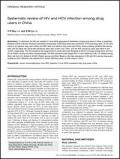Publications - Released in 2008
Since the early 1990s, China has witnessed a dramatic, and incremental, increase in the consumption of illicit drugs, according to data from the National Narcotic Control Commission. At the end of 2005, there were 1.16 million registered drug users in China and around 700,000 heroin addicts, which account for 78.3% of total drug users. The most frequent route of drug administration was intravenous injection (50% to 70%). Although ‘chasing the dragon’ (inhalation of drug fumes) (55%) was a common route in initial heroin users, most drug users made the transition to injecting in order to achieve the same effect at lower doses, and to save on overall costs.
Injecting of drugs and sharing of contaminated needles, and other injecting paraphernalia, have resulted in the transmission of HIV, leading to a high prevalence of HIV and AIDS among injecting drug users (IDUs). Hepatitis C virus (HCV) can be transmitted by injection drug use and it has been identified as the most common viral infection affecting IDUs. Co-infection with HIV and HCV is common in certain populations, especially in IDUs.
Information about HIV and HCV infection, and HIV and HCV co-infection was obtained in separate studies but no overall profile of HIV and HCV co-infections and no detailed geographical variation studies in China were found to exist. This systematic review will present a detailed geographical distribution pattern of HIV, HCV infection and HIV and HCV co-infection among drug users of China.






